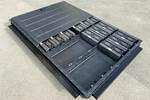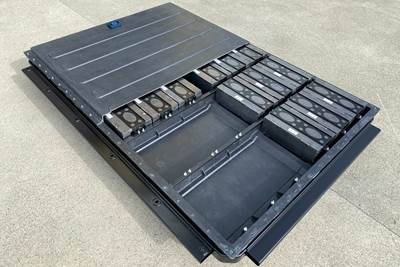Teijin, Applied EV develop composite autonomous vehicle platform
One-piece glass fiber-reinforced SMC structural shell reduces 20% weight and manufacturing complexity of the zero-emissions Blanc Robot platform.

Photo Credit: Teijin Ltd.
Teijin Ltd. (Tokoyo, Japan) announced on Feb. 2 that the company and its joint development partner Applied Electric Vehicles (AEV, Melbourne, Australia) have achieved a major milestone toward a shared vision for zero-emission future mobility with the delivery of a production-ready, one-piece structural shell for Applied EV’s zero-emission robotic vehicle platform, the Blanc Robot.
Launched as a joint development initiative in 2019 to establish a technological foundation for supporting multipurpose zero-emission vehicles for a future society, the Blanc Robot is a programmable, autonomous electric vehicle (EV) platform, designed and engineered by AEV. Built around a core of electronics and mechatronics, running purely on software, it can integrate with many autonomous systems, carry a range of vehicle bodies and serve many purposes, including industrial, delivery and surveillance applications. The Blanc Robot is designed specifically for autonomous operation.
Incorporating Teijin’s lightweight, highly efficient material technology and expertise in composites manufacturing into the platform’s shell component design resulted in the AEV’s ability to significantly reduce the weight and manufacturing complexity of the vehicle, enabling AEV to achieve low mass, high energy efficiency and excellent structural performance.
Both companies are continuing to work together to further utilize Teijin lightweight material technologies for a range of other components, including structural elements, glazing and exterior body panels for use in production EV’s in the latter half of 2022.
The Blanc Robot’s shell, or top cover, is the largest single component on the vehicle, measuring about four square meters in total. It is made from lightweight, high-strength and highly rigid glass fiber-reinforced SMC (GF-SMC) and uses molding technology provided by Continental Structural Plastics (CSP, Auburn Hills, Mich., U.S.), the Teijin Group’s core automotive-composites business. CSP’s proprietary GF-SMC enables the Blanc Robot’s shell to weigh approximately 20% less than an aluminum equivalent component and is said to significantly simplify the manufacturing process.
CSP's molding technology also enables the integral molding of a sheet into thin, complicated shapes that are difficult to achieve using metal. Moreover, molding requires around three minutes. The GF-SMC shell protects the autonomous platform’s crucial equipment inside from damage and the shell achieves excellent fire resistance, dimensional stability and corrosion resistance.
“Our joint development with Teijin is driving product innovation for mobility markets,” says Julian Broadbent, CEO of Applied EV. “Teijin's materials and technology allow us to achieve mass, energy efficiency and cost results that cannot be achieved using more traditional methods. Using GF-SMC for this critical component provided a great deal of design and engineering freedom, which fundamentally changed our manufacturing method and capital cost, allowing us to be more competitive. It also creates a more energy-efficient and sustainable transport solution.”
Applied EV unveiled the Blanc Robot at CES, one of the largest global trade shows to showcase new products and technologies in the consumer electronics industry. Updates of ongoing developments will also be posted on Teijin Mobility Online, an exhibition website introducing Teijin’s mobility-related technologies and products.
“We expect our collaboration with Applied EV to help meet important needs in society by offering new solutions for automotive applications based on advanced materials and structural design required in next-generation EVs,” says Toshiaki Hotaka, general manager, Mobility Division of Teijin Ltd. “Aiming to become a company that supports the society of the future, we have designated environmental value solutions as one of Teijin’s priority fields for contributing to circular economies and sustainability.”
Related Content
Multi-material steel/composite leaf spring targets lightweight, high-volume applications
Rassini International was challenged by Ford Motor Co. to take weight out of the F-150 pickup truck. Rassini responded with a multi-material steel/composite hybrid leaf spring system that can be manufactured at high volumes.
Read MoreThermoset-thermoplastic joining, natural fibers enable sustainability-focused brake cover
Award-winning motorcycle brake disc cover showcases potential for KTM Technologies’ Conexus joining technology and flax fiber composites.
Read MoreCFRTP enables better, greener smartphones
Carbon Mobile’s “monocoque” design eliminates separate case, cover and frame, better protects electronics and simplifies disassembly.
Read MoreASCEND program update: Designing next-gen, high-rate auto and aerospace composites
GKN Aerospace, McLaren Automotive and U.K.-based partners share goals and progress aiming at high-rate, Industry 4.0-enabled, sustainable materials and processes.
Read MoreRead Next
CSP Advanced Materials Center unveils composite battery enclosure and material innovations
Transition into broader R&D capabilities include honeycomb manufacturing process for ultra-lightweight Class A panels and a full-sized, multi-material battery enclosure featuring a one-piece composite cover.
Read MoreFrom the CW Archives: The tale of the thermoplastic cryotank
In 2006, guest columnist Bob Hartunian related the story of his efforts two decades prior, while at McDonnell Douglas, to develop a thermoplastic composite crytank for hydrogen storage. He learned a lot of lessons.
Read MoreComposites end markets: Energy (2024)
Composites are used widely in oil/gas, wind and other renewable energy applications. Despite market challenges, growth potential and innovation for composites continue.
Read More












.jpg;maxWidth=300;quality=90)













